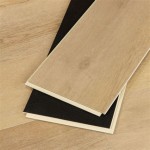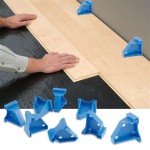What To Consider When Choosing Flooring
Selecting the right flooring for a home or business is a significant decision that impacts aesthetics, functionality, and budget. Flooring is a long-term investment, and careful consideration of various factors is crucial to ensure satisfaction and optimal performance. This article will explore key aspects to evaluate when choosing flooring, ensuring an informed and appropriate selection.
Understanding Lifestyle and Usage
The first and foremost consideration revolves around the lifestyle and usage patterns of the space. This involves analyzing foot traffic, potential for spills and stains, presence of pets or children, and general activity levels. Identifying these aspects will narrow down the range of suitable flooring options.
High-traffic areas, such as hallways, kitchens, and entryways, demand durable and resilient flooring materials capable of withstanding constant wear and tear. Options like hardwood (particularly engineered hardwood), tile, and laminate are often preferred for these spaces. These materials offer resistance to scratches, dents, and stains, making them suitable for busy environments.
Areas prone to moisture, such as bathrooms and laundry rooms, require water-resistant or waterproof flooring. Porcelain or ceramic tile are excellent choices due to their impervious nature. Vinyl flooring, particularly luxury vinyl plank (LVP) and luxury vinyl tile (LVT), also offer excellent water resistance and are becoming increasingly popular for these applications.
Homes with pets and children necessitate flooring materials that are easy to clean and maintain, resistant to scratches and stains, and comfortable underfoot. Laminate, vinyl, and certain types of carpet can be ideal choices. Consider selecting carpets with stain-resistant treatments and low pile heights to simplify cleaning.
Furthermore, consider the specific activities that will take place in each room. For instance, a home gym would benefit from flooring that provides adequate cushioning and shock absorption, such as rubber flooring or specialized athletic surfaces. A home office might prioritize sound absorption, in which case carpet or cork flooring could be considered.
Ultimately, a thorough assessment of lifestyle and usage patterns will provide a clear understanding of the performance requirements the flooring must meet. This will guide the selection process and prevent costly mistakes down the line.
Evaluating Flooring Materials and Their Properties
The market offers a wide array of flooring materials, each possessing distinct characteristics and properties. Understanding these properties is essential for making an informed decision that aligns with both functional requirements and aesthetic preferences. Some of the most common flooring materials include hardwood, laminate, vinyl, tile, carpet, and stone.
Hardwood flooring is a classic and timeless choice, known for its natural beauty and durability. Solid hardwood is made from a single piece of wood, while engineered hardwood consists of a thin layer of hardwood veneer bonded to a core of plywood or high-density fiberboard (HDF). Engineered hardwood is more dimensionally stable than solid hardwood, making it less susceptible to warping or cupping in humid environments. Hardwood flooring offers a warm and inviting aesthetic, and it can be refinished multiple times to extend its lifespan.
Laminate flooring is a synthetic material designed to mimic the appearance of hardwood or tile. It consists of a photographic image of wood or tile bonded to a core of HDF or particleboard and covered with a durable wear layer. Laminate flooring is generally more affordable than hardwood and is relatively easy to install. It is also resistant to scratches, stains, and fading, making it a good choice for high-traffic areas. However, laminate flooring is not water-resistant, and it can be damaged by standing water.
Vinyl flooring is a versatile and durable option that is available in a variety of styles and formats, including sheet vinyl, vinyl tile, and luxury vinyl plank (LVP). Vinyl flooring is water-resistant or waterproof, making it suitable for bathrooms, kitchens, and laundry rooms. It is also relatively easy to clean and maintain. LVP and LVT are particularly popular due to their realistic wood or tile look and their ability to withstand heavy traffic.
Tile flooring is a durable and waterproof option that is ideal for bathrooms, kitchens, and other areas prone to moisture. Porcelain tile is denser and more water-resistant than ceramic tile, making it a better choice for high-moisture environments. Tile flooring is also resistant to scratches, stains, and fading. However, tile can be cold and hard underfoot, and it can be more difficult to install than other types of flooring.
Carpet flooring provides warmth, comfort, and sound absorption. It is available in a wide range of colors, styles, and textures. Carpet is a good choice for bedrooms, living rooms, and other areas where comfort is a priority. However, carpet can be prone to stains and allergens, and it requires regular cleaning and maintenance.
Stone flooring, such as marble, granite, and slate, offers a luxurious and durable option for high-end applications. Stone flooring is naturally beautiful and resistant to scratches, stains, and fading. However, it can be expensive and requires professional installation. Stone flooring can also be cold and hard underfoot.
In addition to these common materials, other options include cork flooring, bamboo flooring, rubber flooring, and epoxy flooring. Each material has its own unique set of properties and benefits, and it is important to carefully consider these properties when making a flooring selection.
Considering Aesthetic Preferences and Design Compatibility
While functionality and durability are paramount, the aesthetic appeal of the flooring cannot be overlooked. The flooring should complement the overall design of the space and reflect the desired style. This involves considering factors such as color, pattern, texture, and overall appearance.
Color plays a significant role in setting the mood and atmosphere of a room. Light-colored flooring can make a room feel larger and brighter, while dark-colored flooring can create a sense of warmth and intimacy. Neutral colors, such as beige, gray, and white, are versatile and can be easily coordinated with a variety of decor styles.
Pattern and texture can add visual interest and depth to a space. Flooring with intricate patterns or textures can become a focal point in the room. However, it is important to use patterns and textures sparingly to avoid overwhelming the space. Smooth and polished surfaces tend to reflect more light, while textured surfaces tend to absorb light and create a more matte finish.
The overall appearance of the flooring should complement the architectural style of the home or building. For example, hardwood flooring is often a good choice for traditional or classic homes, while concrete or tile flooring may be more appropriate for modern or contemporary spaces. The chosen flooring should also coordinate with the existing furniture, wall colors, and window treatments.
Consider the impact of natural light on the flooring. Different types of flooring will react differently to sunlight. Some materials, such as hardwood, may fade or discolor over time if exposed to direct sunlight. It is important to choose flooring that is resistant to fading or to take steps to protect it from sunlight, such as using window coverings.
It is also advisable to collect samples of different flooring options and view them in the actual space to get a better sense of how they will look in different lighting conditions. Online visualizers and design tools can also be helpful in exploring different flooring options and visualizing how they will look in a room.
Ultimately, the chosen flooring should create a cohesive and visually appealing space that reflects the personal style and preferences of the occupants.
Budget and Installation Costs
Budget is inevitably a significant factor in the flooring selection process. The cost of flooring can vary widely depending on the material, quality, and installation requirements. It is crucial to establish a realistic budget and to consider both the upfront costs and the long-term maintenance expenses.
In addition to the cost of the flooring material itself, it is important to factor in the cost of installation. Some flooring materials, such as laminate and vinyl, can be installed by homeowners with basic DIY skills, while others, such as tile and hardwood, typically require professional installation. Professional installation can add significantly to the overall cost of the project.
Consider the need for subfloor preparation. In some cases, the existing subfloor may need to be leveled or repaired before the new flooring can be installed. This can add to the overall cost and timeline of the project.
Obtain quotes from multiple flooring contractors to compare prices and services. Be sure to ask for a detailed breakdown of the costs, including materials, labor, and any additional fees. Check the contractor's references and ensure that they are licensed and insured.
Explore financing options if necessary. Some flooring retailers offer financing plans or payment options that can make it easier to afford the project. However, be sure to carefully review the terms and conditions of any financing agreement before committing.
Consider the long-term cost of ownership. Some flooring materials require more maintenance than others. For example, carpet needs to be professionally cleaned regularly, while hardwood may need to be refinished periodically. Factor in these ongoing costs when making a flooring selection.
While it is tempting to choose the cheapest flooring option, it is important to consider the quality and durability of the material. Investing in a higher-quality flooring material may save money in the long run by reducing the need for repairs or replacements.
Maintenance and Longevity
The longevity and ease of maintenance are crucial considerations for selecting the appropriate flooring. Different flooring materials have varying maintenance requirements, affecting long-term costs and effort involved in keeping the floor in optimum condition.
Hardwood flooring, while beautiful and durable, requires regular cleaning and occasional refinishing to maintain its luster. Regular sweeping or vacuuming removes debris that can scratch the surface. Periodic cleaning with specialized hardwood floor cleaners helps remove dirt and grime. Refinishing, typically required every 7-10 years depending on traffic, involves sanding down the existing finish and applying a new coat of polyurethane or varnish.
Laminate flooring is relatively easy to maintain, requiring only sweeping or vacuuming and occasional damp mopping. However, it is susceptible to moisture damage and should be cleaned carefully to prevent water from seeping into seams. Avoid using excessive water or harsh chemicals that can damage the surface.
Vinyl flooring is known for its low maintenance requirements. It is water-resistant and easy to clean with a damp mop and mild detergent. Regular sweeping or vacuuming removes loose dirt and debris. Vinyl flooring is also resistant to stains and scratches, making it a durable and long-lasting option.
Tile flooring is another low-maintenance option. It is water-resistant and easy to clean with a damp mop and mild detergent. Grout lines, however, can be susceptible to staining and may require periodic cleaning with specialized grout cleaners. Sealing the grout can help prevent staining and make it easier to clean.
Carpet requires regular vacuuming to remove dirt, dust, and allergens. Periodic professional cleaning is also recommended to remove deep-seated stains and dirt. Stain-resistant treatments can help protect the carpet from spills and stains. Consider the pile height and fiber type when choosing carpet, as some types are easier to maintain than others.
Stone flooring requires regular sealing to protect it from stains and moisture. Cleaning with pH-neutral cleaners is recommended to avoid damaging the surface. Polishing stone flooring can help maintain its shine and luster.
By carefully considering the maintenance requirements and longevity of different flooring materials, homeowners can choose an option that suits their lifestyle and budget, ensuring a beautiful and durable floor for years to come.

5 Things To Consider When Choosing Floor Color

Here S What To Consider When Choosing Flooring For Your Home

Home Office Flooring Ideas 50floor

Factors To Consider When Choosing Flooring Imagine Floors

How To Choose The Right Flooring For Your Home

What To Consider When Choosing Flooring For Your Home Hardwood In Toronto Laminate Engineered And Bamboo Floors

Tips For Choosing The Right Color Of Flooring Your Home In San Francisco Bay Area Floor

How To Choose Flooring

Complete Guide To Choosing And Installing Hardwood Flooring

Tips How To Choose Flooring For Your Home Ella Claire Co
Related Posts








